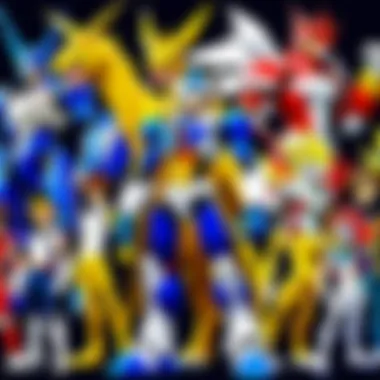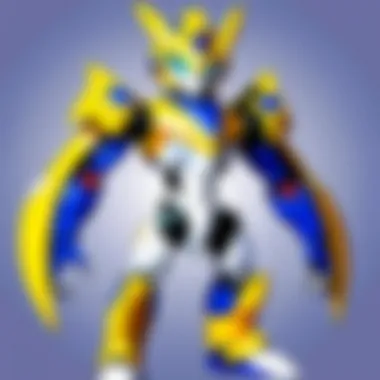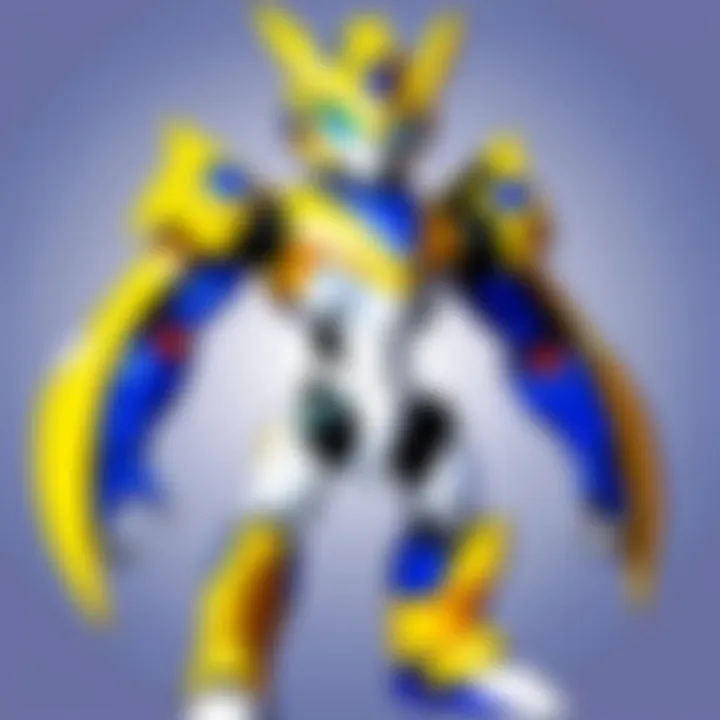A Comprehensive Guide to the Digimon Series Order


Intro
The Digimon franchise has evolved significantly since its inception in the late 1990s, capturing the imaginations of audiences across the globe. This guide aims to dissect the various series, movies, and spin-offs, providing a clear roadmap for understanding the chronological order of these works. By exploring the narrative arcs, character evolution, and thematic elements, this article serves as a critical resource for anyone interested in immersing themselves in the rich lore of the Digimon universe.
Fans often find themselves overwhelmed by the sheer volume of content. From Digimon Adventure to Digimon Survive, each installment introduces unique elements. Analyzing these connections allows one to appreciate the depth of storytelling that defines the series.
Episode Reviews
Summary of the episode
Each episode in the Digimon series offers distinct storytelling and character challenges. The narratives often revolve around themes of friendship, courage, and self-discovery, making them relatable to a diverse audience. For example, in Digimon Adventure, the main characters, known as the DigiDestined, journey through the Digital World to save both their newfound friends and their own world.
Analysis of key events
Key events, like the evolution of a Digimon or the confrontation with a formidable antagonist, are pivotal moments in the series. These events not only advance the plot but also serve as crucial turning points for character development.
Discussion on character development
The character arcs range from personal growth to the development of deeper relationships among the DigiDestined. For instance, in Digimon Tamers, themes of existentialism are prevalent as characters grapple with their identities and the realities of their digital counterparts.
Highlight memorable moments
Memorable moments often include heart-wrenching farewells or thrilling battles that leave audiences questioning the fate of characters. Digimon Adventure tri. revitalized these feelings, showcasing emotional depth and nostalgia for long-time fans.
Character Spotlights
Background information on the character
Focusing on character profiles enhances understanding of their journeys. Take Tai Kamiya, for example. His growth from a carefree boy to a responsible leader exemplifies the series' focus on coming-of-age narratives.
Personality traits and unique quirks
Personality is key within the series. Characters possess distinct traits, such as Kari Kamiya’s compassion or Matt Ishida's stubbornness, which influence their decisions and relationships.
Role in the storyline
Each character serves a vital role within their respective arcs. Their contributions often resonate with overarching themes of sacrifice and teamwork.
Fan theories and speculations
Fan communities actively discuss theories regarding characters' hidden motivations. For instance, speculation around Mimi Tachikawa’s evolution throughout the series reflects her growth and challenges faced in both the Digital and real worlds.
Anime vs. Manga Comparison
Plot differences between the anime and manga
Different adaptations yield unique interpretations of the Digimon story. The manga often delves deeper into lore and character backgrounds, whereas the anime emphasizes action and emotional storytelling.
Art and animation quality
Animation quality plays a significant role in how stories are received. While early anime installments faced criticisms for their animation, later series, such as Digimon Adventures: Last Evolution Kizuna, showcase improved art and fluidity.
Character portrayal
The representation of characters varies between formats, influencing audience connection. The more detailed character studies in manga invite deeper analysis than the episodic nature of the anime.
Fan preferences and opinions
Opinions differ on which medium is superior. Some fans favor the emotional resonance of the anime, while others prefer the in-depth exploration found in the manga.
Industry News and Updates
Announcements on upcoming releases
The Digimon franchise regularly announces new projects. Recent confirmations include Digimon Survive, a game blending elements of visual novels and strategy, appealing to both gamers and fans of the series.
Analysis of industry trends
The growth of the Digimon franchise parallels trends in the anime industry. An increase in remakes and adaptations reflects a broader revitalization of classic series, introducing them to new audiences.
Insight into the production process
Understanding the production behind Digimon can offer insights into thematic decisions and narrative choices. Behind-the-scenes information often reveals influences that shape the series' direction.
Top Lists
Ranking of favorite characters or episodes
Fans often compile lists ranking their favorite characters or episodes. These rankings reveal personal connections to specific aspects of the series.
Compilation of best fight scenes
Iconic fight scenes, such as those in Digimon Frontier, hold a special place in fans’ hearts, showcasing both strategy and intense emotional stakes.
Comparison of different genres within anime and manga
Comparing Digimon to other anime reveals its unique genre blend of adventure, fantasy, and slice of life, distinguishing it within the industry.
Audience polls and feedback
Community feedback furthers engagement, offering valuable perspectives on the evolving narrative of Digimon.
Preamble to the Digimon Franchise
The Digimon franchise stands as a landmark in the anime and gaming worlds, establishing a rich tapestry of narratives that attract not just children but also older fans. This introductory section sets the stage for a broader exploration of its various series, films, and merchandise. Understanding its beginnings and cultural significance provides context for the intricate connections between the stories and characters that evolve over the decades.
Origins and Evolution
The genesis of Digimon can be traced back to the late 1990s with the introduction of digital pets, which were influenced by the interactive Tamagotchi. The original series, "Digimon Adventure," debuted in 1999. It quickly captivated audiences with its unique blend of adventure and the childhood themes of friendship and bravery. Each subsequent installment of the franchise built upon the foundation laid by its predecessors, refining its messages while broadening its reach.
Digimon's evolution has been characterized by persistent innovation in storytelling. The franchise transitioned from seasonal series to incorporating movies and spin-offs, each adding layers to the overarching lore. Fans have witnessed the introduction of new character dynamics, settings, and challenges, constantly refreshing the narrative landscape. This evolution also reflects changing global perspectives on the themes inherent in the series, such as the balance of technology and nature.
"In the world of Digimon, every adventure is a chance for growth, both for the characters and for the franchise itself."


Cultural Impact and Popularity
The cultural reach of Digimon is substantial, permeating various areas of popular culture. From its inception, it has established a dedicated fan base, which remains active across numerous social platforms like Reddit and Facebook. The franchise has fostered community engagement through discussions on character arcs, theories about plot developments, and nostalgia for childhood experience with the series.
Moreover, Digimon has had a significant influence on anime as a genre. It introduced diverse character development and complex narratives, which stood in contrast to other children's programming of the time. Its exploration of relationships, personal growth, and the consequences of technology has resonated with audiences of all ages. The combination of unique monster designs and compelling stories has solidified its place as a cornerstone of anime fandom.
Overall, the Digimon franchise encapsulates a vibrant cultural phenomenon, with its roots firmly planted in nostalgia while branching out to appeal to a new generation. Its ongoing relevance in the discussion of technology and companionship underscores its ability to resonate in today's society.
The Main Series: An Overview
The main series of the Digimon franchise plays a pivotal role in establishing its expansive universe. This overview is essential for understanding how each series contributes to character development, thematic depth, and continuity in the overall narrative. The main series serves as the core around which other stories, spin-offs, and films revolve.
Each installment introduces unique concepts and characters while maintaining connections through familiar elements. This connection enhances the experience for long-time fans, who appreciate the consistency in storytelling and ensemble dynamics.
Key elements of the main series include its diverse narrative styles and the evolution of its themes. Each series tackles different challenges and growth journeys for characters, enriching the lore that surrounds the Digimon world. Analyzing the main series helps to grasp the intricate web of relationships and events that define this beloved franchise.
Adventure Series
The Adventure series represents the foundational aspect of Digimon storytelling. It introduced primary characters and established the core concepts that define the franchise. Each iteration within the Adventure series, starting from the original Digimon Adventure, focuses on the journey of children and their digital companions.
The relationships formed between these characters and their Digimon are integral. Characters grow and evolve as they face challenges and adversaries together. This growth is not just personal but also communal, as missteps and victories strengthen bonds and friendships.
Moreover, these series highlight themes of teamwork, confrontation with personal fears, and the significance of friendship. Fans appreciate how these universal themes resonate across various cultures, allowing the series to maintain relevance.
Seasonal Formats
The seasonal formats of Digimon present the franchise's adaptability and creativity. Each season often introduces a new setting, group of characters, and even a different premise. For example, while Digimon Adventure centers on a group of children in a digital world, Digimon Tamers takes a different route by incorporating a more mature narrative.
This shift demonstrates the franchise's ability to cater to its audience's evolving tastes. Each seasonal format emphasizes distinct storytelling techniques, broadening the franchise’s appeal. Younger viewers may be attracted to adventure and camaraderie, while older audiences might appreciate deeper narrative layers and character arcs.
Through these diverse approaches, the series continues to captivate audiences. It ensures that both new viewers and seasoned fans can find something relatable and enriching. This format flexibility allows for exploration of various themes and character types, which in turn promotes longevity and sustained interest in the Digimon series.
"The Digimon franchise remains a dynamic entity that thrives on its capacity to innovate while respecting its origins. Each series is a reflection of not only its unique narrative style but also the time in which it was produced."
Digimon Adventure
Digimon Adventure holds a pivotal position within the Digimon franchise. As the inaugural series, it established foundational elements that resonate throughout subsequent iterations. This series introduced audiences to the Digital World and the concept of Digivolution, making it a crucial starting point for new fans. Understanding Digimon Adventure serves as a gateway to appreciating the narratives and characters in later series.
Plot Summary
The plot of Digimon Adventure revolves around a group of children who are transported to the Digital World, where they encounter their Digimon partners. These children, also called the "DigiDestined," are tasked with protecting both their world and the Digital World from various threats. The story succinctly chronicles their journeys as they grow, both in terms of strength and character.
As the DigiDestined confront hostile Digimon and other challenges, they develop bonds with their partners. Central to the plot are their adventures against formidable foes like Devimon and Garudamon. The mixture of personal dilemmas and grand-scale conflicts makes this series engaging for both younger and older audiences.
Character Profiles
Characters in Digimon Adventure are well-developed, each exhibiting unique qualities that facilitate a rich interaction with the series' themes. The protagonists include Tai, who is courageous but often reckless; Matt, who has a cool demeanor hiding deeper emotions; and Sora, who balances empathy with strength. Each character navigates personal growth and relationships with their DigiPartners. The relationships evolve as they face various adversities, enhancing depth to character profiles.
New characters are introduced throughout the series, contributing to its ongoing development. The relationships among the DigiDestined and their Digimon are crucial to the narrative.
Themes and Motifs
Digimon Adventure explores themes of friendship, bravery, and the journey to self-discovery. The evolving friendships between the DigiDestined and their Digimon partners represent loyalty and trust. The series also delves into the ideals of courage versus fear, often presenting characters with moral dilemmas that challenge their beliefs and team dynamics.
Motifs such as teamwork resonate throughout the series. The need for collaboration to overcome obstacles is a recurring message. Additionally, Digivolution serves as both a literal and figurative metaphor for personal growth, reflecting how the characters transform through their experiences.
"Digimon Adventure presents a narrative that intertwines individual growth with collective challenges, making it a compelling watch for fans of all ages."
With layers of intricate storytelling, Digimon Adventure sets the stage for all future narratives in the Digimon universe. Its emphasis on character development and thematic richness ensures it remains a cornerstone of the franchise.
Digimon Adventure
Digimon Adventure 02 plays a pivotal role in the evolution of the Digimon franchise. Not only does it serve as a direct sequel to its predecessor, but it also expands the lore and character dynamics within the Digimon universe. Understanding this series is essential for grasping how it builds upon the foundations laid in the original series, introducing new themes and enhancing character development. This section aims to illuminate the continuity and development aspects of Digimon Adventure 02, along with the introduction of new characters, which all contribute to its significance in the broader Digimon narrative.
Continuity and Development
Digimon Adventure 02 succeeds the original Digimon Adventure, continuing the story by bringing back familiar characters while integrating fresh narratives. It is crucial because it maintains continuity in character arcs and themes. The series shows how the characters have grown; they are not the same children who ventured into the Digital World earlier.
By starting in a post-adventure state, the series showcases the challenges of adolescence. The question of responsibility surfaces as the characters face new issues, showing their maturity or lack thereof. The presence of the D-Reaper hints at a darker tone, which parallels real-life issues adolescents face, such as isolation and personal growth. The approach taken in this series allows for an exploration of serious themes, diverging from the original series’ more lighthearted elements.
Additionally, Adventure 02 introduces a new Digital Championship arc. This storyline emphasizes teamwork and strategy in tackling challenges. The evolving relationship between the DigiDestined becomes more layered. For instance, Ken Ichijouji's arc is particularly notable as it intertwines redemption and forgiveness, illustrating that characters can overcome their darker pasts.
"For fans of the series, the development of Ken's character provides a profound insight into themes of regret and acceptance, reflecting on adolescent transformations."
New Characters Introduced
The introduction of new characters is a significant aspect of Digimon Adventure 02. It does not merely recycle previous characters but enriches the series with fresh personalities that play critical roles.
One of the central figures is Daisuke Motomiya. As the new protagonist, Daisuke embodies the spirit of adventure and bravery. He often contrasts with the established characters, showcasing a youthful vigor that is essential to differentiate his role in the group. This new energy opens new avenues for conflict and development within the story.
Alongside Daisuke, the character of Ken Ichijouji represents a compelling journey of transformation. Ken starts as an antagonist but gradually evolves into a protagonist, showcasing a narrative about facing one’s inner demons. His complexity enriches the story and emphasizes the notion that change is always possible.
Also noteworthy is Yolei Inoue, whose character may initially seem secondary but plays a key role in balancing emotions within the group. The ensemble leads to dynamic interactions and heartfelt moments, which elevate the overall engagement of the audience. Each character contributes unique qualities that enhance the main themes of friendship, bravery, and the comforting power of community.
Digimon Tamers
Digimon Tamers represents a significant evolution within the Digimon franchise, introducing a more mature narrative and deeper themes compared to its predecessors. This series is notable for moving away from the traditional characters and structures found in earlier entries. Instead, it focuses on a fresh approach that emphasizes individual growth and moral dilemmas. Digimon Tamers not only captivates audiences with its lively action but also engages them on a deeper emotional level, making it a cornerstone of the overall Digimon mythology.
Narrative Style and Approach
The narrative style of Digimon Tamers stands out for its realism and complexity. It shifts from the simplicity of earlier series to a storyline that incorporates psychological elements and intricate character arcs. This series depicts a world where Digimon are perceived as products of a card game, blending fantasy and reality.
Characters like Takato Matsuki navigate their emotional struggles, showcasing a genuine sense of fear and responsibility. The narrative incorporates darker themes, such as the consequences of choices and the idea of artificial life.
The pacing is thoughtfully managed, allowing for both exhilarating battles and contemplative moments. Through its storytelling approach, it creates an environment where viewers can connect with characters on a personal level. The dialogue also reveals the internal conflicts faced by the protagonists, further enriching the viewing experience.
Character Complexity
Character complexity is one of the most distinctive features of Digimon Tamers. Each character is well-developed, undergoing significant transformations throughout the series. Takato, for example, serves as a reflection of innocence and gradual maturity. He learns that his actions have real consequences, not just in the game, but in the emotional realm as well. His evolution from a naive boy to a responsible individual underscores the series' thematic depth.
Other characters like Rika Furude and Henry Wong complement this narrative depth. Rika grapples with vulnerability masked by a tough exterior, while Henry embodies the struggle to balance empathy with pragmatism.
The relationships among these characters form a rich tapestry, as their interactions foster personal growth. This series gives importance to emotional bonds, highlighting the significance of friendship and trust amidst chaos.
"In Digimon Tamers, each character's personal struggle mirrors the overall themes of growth and responsibility, propelling the narrative beyond mere entertainment."


By presenting flawed and relatable characters, Digimon Tamers elevates itself from being simply a kids’ show. It maintains relevance for a more mature audience, providing insights into the human condition through the lens of a fantastical narrative.
Digimon Frontier
Digimon Frontier represents a distinct phase in the Digimon series. It introduces a fresh narrative structure while maintaining core elements of the franchise. In this installment, human characters transform into Digimon, leading to a different storytelling approach compared to earlier series. This facet is significant, as it emphasizes the concept of evolution not just for Digimon, but for humans as well.
The series emerged during a time when the franchise sought innovation. Many fans appreciate how this series departures from the usual partner dynamic found in other entries. Over time, it has gained a unique reputation, attracting viewers intrigued by its unconventional mechanics and character development.
Innovations in Storytelling
Digimon Frontier is known for its innovative storytelling techniques, setting it apart from its predecessors. The narrative focuses primarily on human characters who play a dual role: they are both protagonists and instruments of transformation into Digimon. Each character has a unique Digivolution style, which adds a layer of complexity and depth to the plot.
Furthermore, the series relies heavily on a form of narrative fluidity. The adventure unfolds in a linear yet imaginative way. Characters embark on a journey that is anything but predictable. This approach allows writers to explore themes and character arcs in ways that resonate with audiences. The transformation of humans into Digimon fosters a sense of unity, showcasing the connection between aspirations and struggles, both in human and Digimon forms.
In essence, this storytelling innovation has enriched the series, inviting audiences to rethink traditional hero narratives.
Themes of Sacrifice and Growth
Themes of sacrifice and growth are prevalent throughout Digimon Frontier. Characters face immense challenges that test their resolve and principles. The notion of sacrifice emerges as not only physical but also emotional and psychological as well. For instance, the characters must confront their fears to protect their friends and the Digital World.
Growth, on the other hand, is depicted in various forms. One prominent element is the evolution of the main characters. By tapping into their inner strengths and vulnerabilities, they attain new levels of personal maturity and understanding.
"Characters grow through facing dilemmas that reshape their identities and relationships."
This dual theme illustrates the broader message of the series: one must undergo trials to grow and evolve. It reflects not just the journey of the characters but resonates with the audience's personal experiences and growth, making it a significant aspect of the Digimon Frontier series.
Digimon Data Squad
Digimon Data Squad, also known as Digimon Savers, represents a significant entry in the Digimon franchise. This series takes a unique approach to storytelling, differentiating it from the previous installments. Setting it apart is its focus on a slightly older audience, incorporating deeper themes and more mature character development.
This series explores complex ideas such as justice, responsibility, and friendship. It delves into the consequences of actions in a way that resonates with viewers. Data Squad's narrative builds a bridge connecting digital and real-world elements, allowing audiences to relate more closely to the characters and their struggles.
Plot Characteristics
The plot of Digimon Data Squad revolves around a young human, Masaru Dan, and his partner Digimon, Agumon. Together, they face various threats from rogue Digimon while uncovering a secret organization called the DATS (Digital Accident Tactics Squad). The series introduces a more structured approach to the conflict, contrasting with previous formats that often used episodic structures.
The main storyline unfolds over the course of 48 episodes. Each arc emphasizes intense battles and character growth. The narrative structure integrates action and drama effectively, revealing motivations and moral dilemmas. Overall, the story is marked by its pacing. It combines conflicts between humans and Digimon with overarching themes of friendship and loyalty.
A notable characteristic is the blend of adventure with a crime-fighting motif. This uncommon approach provides a fresh take on the franchise. It introduces a variety of antagonists, each with diverse backgrounds and motivations. The complexity of the plot keeps the audience engaged and invested in the outcomes of the characters.
Character Arcs
Character development is central to the appeal of Digimon Data Squad. The series features a range of characters, each experiencing significant growth. Masaru Dan embodies determination and bravery. His evolution reflects the learning process of embracing one's responsibilities, especially as he learns more about Digimon and their world.
Other key characters, like the intelligent and well-planned Yoshino Fujieda, offer contrasting perspectives to Masaru’s impulsiveness. This dynamic enhances the narrative's depth, showcasing themes of teamwork and collaboration.
Additionally, the characters' relationships with their Digimon partners serve as the emotional heart of the series. As they face challenges, the bond strengthens, emphasizing the core values of trust and friendship. Each character’s development contributes to the broader themes present in the series, illustrating how personal struggles can connect with greater conflicts.
The emotional journeys in Digimon Data Squad highlight the interplay between human and Digimon experiences, showcasing the complexities of bonds that transcend realms.
Overall, Digimon Data Squad exemplifies how the Digimon franchise can evolve while still capturing the essence of its roots. Its focus on deeper narrative elements and character relationships results in a memorable addition to the series.
Digimon Fusion
Digimon Fusion offers a unique approach to storytelling within the franchise. This installment distinguishes itself by emphasizing the concept of merging different Digimon to create new, enhanced forms. The importance of this topic in the broader scope of the Digimon universe cannot be understated. It highlights themes of collaboration, innovation, and the significance of bonds between characters, both human and Digimon.
The series navigates through complex narratives that unfold as characters learn to embrace their differences to achieve greater strength. At its core, Digimon Fusion focuses on the idea that teamwork and unity can create formidable forces in the face of adversity. Furthermore, it expands on the mechanics of evolution, providing fresh opportunities for character growth and conflict resolution.
Fusion Concepts
In Digimon Fusion, the fusions are not merely physical transformations but also encapsulate the identities and personalities of the Digimon involved. This layered approach allows for varying degrees of synergy between characters. Fusions can be spontaneous or strategic, depending on the situation. This adds an element of surprise and excitement, as fans never quite know which digimon will combine and what new abilities will emerge.
- Types of Fusions: The series introduces several types of fusion techniques, each with its own rules and implications. These include:
- Strategic Applications: The tactical element is vital. Characters must assess their partners and choose wisely for the best outcome, revealing how planning and strategy play crucial roles in their battles.
- Standard Fusion: This is the most basic form, combining two Digimon to form a more powerful one.
- Mega Fusion: Involves multiple Digimon coming together, typically resulting in an ultimate form with enhanced capabilities.
- Digi-Fusion: This concept allows characters to fuse with their Digimon partners, leading to shared abilities and skills.
Character Dynamics
Character interactions in Digimon Fusion are rich and multi-faceted. Each fusion reflects not just physical traits, but emotional connections and the internal struggles faced by the characters themselves. This narrative approach gives viewers an opportunity to witness characters evolve as they learn more about trust and companionship.
- Partner Relationships: The bond between human and Digimon partners becomes evident, highlighting themes of friendship and loyalty. Fusions can serve as metaphors for growth in these relationships, marked by challenges and triumphs.
- Conflict and Resolution: The dynamics often create conflicts that characters must navigate. These moments of tension propel the narrative forward, as characters face their insecurities and grow stronger from their experiences.
"In Digimon Fusion, the strength of a team is not defined by individual power but by how well members can complement each other through fusion."
Overall, Digimon Fusion represents an important evolution in the series. It serves to deepen thematic elements of connectivity and unity, fostering a rich narrative texture that resonates with audiences, both young and old.
Digimon Adventure Tri.
Digimon Adventure Tri. holds a significant place in the Digimon franchise. Released to mark the franchise's 15th anniversary, it reintroduces key elements from the original series while exploring deeper themes of growth, loss, and the complexities of adolescence. This series is essential for understanding the evolution of character dynamics and the overarching narrative that connects various installments. It serves not only as a nostalgic return for longtime fans but also as a gateway for new audiences to engage with the deeper narratives of Digimon.
Evolving Themes
In Digimon Adventure Tri., the themes resonate with the challenges and experiences faced by teenagers transitioning into adulthood. The story does not shy away from the realities of growing up, including the stress of expectations, the ache of loss, and the search for identity. Key thematic elements include:
- Friendship and Disconnection: The bond between the characters is tested as they confront personal struggles.
- Responsibility and Growth: Characters grapple with their roles as DigiDestined, highlighting the burdens that come with responsibility.
- Loss and Grief: The series does not flinch from exploring emotional hardships, thereby offering a mature perspective on how characters cope with loss.
These themes add a layer of depth that distinguishes this segment within the franchise.
Returning Characters
Returning characters play a pivotal role in anchoring the narrative of Digimon Adventure Tri. The original DigiDestined, including Taichi Yagami, Yamato Ishida, and Sora Takenouchi, come back, showcasing their growth over the years. Their development is vital to understanding how their experiences shape their present actions.
This return creates an emotional continuity, allowing viewers to witness the inevitable change that comes with time.
The interactions among these characters explore:
- Nostalgia: Fans feel a connection as they see familiar faces confronting new challenges.
- Character Growth: Each character has undergone personal development, reflecting real-life changes.
- Dynamic Relationships: The evolution of friendships and rivalries adds complexity to the narrative.
Digimon Adventure: Last Evolution Kizuna
Digimon Adventure: Last Evolution Kizuna is a significant milestone in the Digimon franchise, marking a poignant transition for the characters and fans who have followed their journeys over decades. It serves as a direct sequel to the original Digimon Adventure series and encapsulates the legacy of the original DigiDestined. The film explores themes of growth and change, resonating deeply with the original audience, who have aged alongside the characters. This makes Last Evolution Kizuna not just a continuation, but a reflection on the passage of time that affects both the characters and their fans.
This narrative provides a sense of closure, offering insights into the future of beloved characters as they confront the inevitable realities of adulthood. It also emphasizes the inherent transient nature of relationships, particularly how the bond between humans and Digimon evolves as they face new challenges. This installment is essential for understanding how the franchise is evolving while still paying homage to its roots.


Closure and Closure
The conclusion of Last Evolution Kizuna ties together multiple story arcs presented throughout various series. It approaches the idea of letting go, illustrating that growth often necessitates moving forward. The film invites viewers to reflect on their own journeys, encouraging them to cherish memories while accepting change. The narrative deftly intertwines past and present, offering a comprehensive closure to the long-standing saga while also expressing optimism for future adventures.
In summary, this film serves as both an ending and a new beginning. It recognizes the emotional weight of departing from childhood and the adventures that define that period, allowing fans to connect with characters on a more profound level.
Themes of Maturity
Digimon Adventure: Last Evolution Kizuna centers around various themes, with maturity being the most prominent. The film presents maturity not merely as age advancement but as a transformation that involves understanding one's responsibilities and the weight of choices. The characters face critical decisions that influence their futures, particularly in how they relate to their Digimon partners.
The relationships depicted showcase the dichotomy between childhood innocence and adult complexities. Each character's growth across the franchises culminates in this film, highlighting individual journeys of self-discovery.
"Maturity is realizing that life continues to evolve, much like the bonds we form."
The film's portrayal of the challenges that come with maturity resonates with audiences who have shared this journey with the DigiDestined, reinforcing the importance of legacy. As they confront new realities, characters learn to value their experiences, solidifying the idea that every ending leads to new opportunities, and true growth comes from understanding profound connections.
Spin-off Series and Movies
The world of Digimon extends far beyond its main series. To fully appreciate the richness and depth of this franchise, it is essential to examine the spin-off series and movies. These additional narratives not only enhance the lore but also provide alternate storylines that can appeal to different audiences. They often explore themes, characters, and settings that are unique to them, offering fans a broader perspective on the Digimon universe.
Analyzing the Spin-offs
Spin-off series are important in expanding the Digimon narrative. They introduce new characters and scenarios while connecting back to the central themes present in the main series. Notable examples include "Digimon Fusion" and "Digimon Adventure tri.", which, although distinct, reference the original setting and familiar elements.
Key factors to consider include:
- Diverse Storytelling: Each spin-off brings fresh storytelling approaches, with some focusing on action, while others emphasize character development.
- Character Expansion: They often allow lesser-known characters to take center stage, revealing new facets and growth.
- Fan Engagement: Spin-offs cater to diverse fan preferences, leading them to explore various characters and arcs. This keeps the interest alive and promotes longevity in the franchise.
Movies: Standalone Narratives
Digimon movies provide standalone narratives that supplement the main series. They often explore significant events or character developments not fully covered in the TV series. For instance, "Digimon Adventure: Our War Game!" demonstrates how a film can expand on series lore through a focused plot.
These movies often possess their themes, such as:
- Character Growth: Movies sometimes offer a chance for characters to evolve in ways that the series might not have explored.
- Enhanced Visuals: Being films, they typically feature higher production values, leading to an engaging visual experience for fans.
- Themes of Adventure: They usually delve into epic battles or world-saving missions, providing thrilling narratives that resonate with viewers.
Character Development Across Series
Character development serves as a crucial element in the Digimon series. It not only shapes individual characters but also informs the overarching narrative. The evolution of characters allows viewers to connect emotionally with the stories, creating a sense of investment in their journeys. Over time, key figures undergo transformation, influenced by their environments and relationships. This aspect of the series invites analysis and appreciation from both casual viewers and dedicated fans.
Each series within the Digimon franchise offers a unique take on character growth. For example, in Digimon Adventure, protagonists start as naive children, gradually gaining maturity and responsibility. This journey mirrors real-life situations where young individuals face challenges that catalyze personal growth. The series illustrates how characters grapple with their fears and insecurities while developing friendships.
Additionally, the varied approaches to character arcs across series enable a rich tapestry of narrative techniques. In Digimon Tamers, character development takes a more psychological path, highlighting the internal struggles characters face. The narrative challenges the protagonists to confront their own motivations and desires, presenting a stark contrast to the more straightforward growth seen in Digimon Adventure.
By examining character progression, audiences can better appreciate the nuances of storytelling in the Digimon universe. The connections characters form with their Digimon and each other serve to deepen the narrative impact, fostering a lasting bond between the audience and the series.
Key Characters in Focus
Throughout the Digimon series, certain characters stand out due to their significance in driving the plot. For instance, Tai Kamiya from Digimon Adventure is more than just a lead character. His evolution from a carefree child to a responsible leader encapsulates the essence of character development within this franchise. Each challenge he faces alongside Agumon shapes his identity and leadership qualities.
In Digimon Tamers, Takato Matsuki offers a different perspective on character growth. He starts as an overly imaginative boy, whose encounters with real Digimon compel him to confront the difference between imagination and reality. His development extends to recognizing the consequences of his actions, bringing complexity to his character.
Other key characters include Matt Ishida, whose struggle with insecurities complements Tai's leadership style. Their rivalry and friendship reflect broader themes of collaboration and competition found throughout the series.
This exploration of central figures highlights how the showrunners prioritize rich personalities, further enhancing the viewing experience.
Evolution of Relationships
The relationships formed between characters significantly contribute to their development. Whether it is the bond between a DigiDestined and their Digimon or among the humans themselves, these connections are integral to the narrative.
Take the relationship between Yamato "Matt" Ishida and Tai Kamiya. Their friendship is a focal point in Digimon Adventure, characterized by both rivalry and support. This duality allows viewers to see the complexities of human relationships, as they navigate shared goals and personal differences. The evolution of their relationship underscores pivotal themes of camaraderie and growth.
In Digimon Tamers, the bond between Takato and Guilmon reflects a more profound connection, as they navigate the intricacies of their existence together. Their growth leads them to understand the meaning of partnership, emphasizing the importance of teamwork in both personal and larger conflicts.
"Relationship dynamics are central to the characters' journeys, shaping their paths and decisions."
As the series progresses, the evolution of these relationships addresses significant themes such as trust, sacrifice, and understanding. Characters learn to depend on one another, fostering trust that influences their choices. These lessons resonate deeply within the audience, allowing them to reflect on their own relationships.
To sum up, character development and relationship dynamics are essential threads within the Digimon tapestry. They invite viewers into a realm where change and connection define the narrative, leaving a lasting impact on the franchise.
Legacy of the Digimon Series
The legacy of the Digimon series represents not only a significant cultural phenomenon but also a vital aspect of anime history. The franchise has woven itself into the fabric of many childhoods, becoming a source of nostalgia for countless fans around the globe. Spanning over two decades, Digimon has evolved, adapted, and maintained relevance through its various iterations, including television series, movies, games, and merchandise. This rich legacy highlights how the series has consistently engaged its audience, fostering a sense of community and loyalty.
The importance of the Digimon legacy can be observed in several key areas. First, there is the deep connection fans feel towards the characters and stories. Each generation of Digimon protagonists has been crafted with care, allowing for emotional ties to develop. From Taichi Yagami in the original Digimon Adventure to the newer characters in Digimon Adventure: Last Evolution Kizuna, the emotional arcs resonate with audiences of different age groups.
Second, the franchise's thematic depth has expanded over the years. Early instalments focused heavily on friendship and adventure but have since explored more intricate themes such as loss, maturity, and identity. This thematic evolution validates deeper discussions among fans and contributes to the franchise's longevity.
In addition, Digimon's legacy is also evident in its innovative storytelling techniques. Unlike most of its contemporaries, the series often experiments with narrative structures, blending episodic and serialized storytelling. This blend has broadened the scope of traditional anime narratives, pushing the envelope for future series.
Long-term Fan Engagement
Long-term fan engagement is a cornerstone of the Digimon legacy. The series has cultivated a devoted fanbase that extends beyond mere viewership. Online communities on platforms like Reddit and Facebook provide spaces for fans to discuss theories, share art, and celebrate their favorite moments. This collaborative spirit of fandom not only keeps the series alive but also encourages newcomers to join in.
Moreover, events such as Digimon Con demonstrate the active involvement of both fans and creators. These events allow communities to gather, share experiences, and even engage with the original creators. The strong community ties forged through shared interests contribute significantly to the franchise's enduring status.
Future Directions
Looking ahead, the future directions of the Digimon series appear promising. Recent announcements hint at new projects and potential revivals of classic series, reflecting the franchise's resilience. The evolving nature of technology, particularly in animation and digital media, presents opportunities for dynamic storytelling.
Furthermore, themes explored in recent installments suggest a willingness to tackle current societal issues. Addressing topics such as mental health and environmental concerns within the context of Digimon would resonate with audience concerns and enrich the narrative depth.
"The future is bright for Digimon, with legions of fans eager for new stories as the series continues to evolve."
As the Digimon franchise progresses, it is likely to maintain its commitment to innovation and audience engagement, ensuring its legacy endures for future generations.
Finale
The conclusion serves as a vital component of this comprehensive guide to the Digimon series. It encapsulates the essence of what has been discussed throughout the article, tying together the numerous threads of narrative, character development, and thematic evolution. Understanding the conclusion is essential for both seasoned fans and newcomers. It highlights how each series, spin-off, and movie contributes to the overall fabric of the Digimon universe.
Summary of Key Points
- The Digimon franchise presents a complex and varied narrative that evolves across different series and formats.
- Each series introduces new characters and thematic elements, enriching the overall story and fan engagement.
- Key points covered include character arcs, changing dynamics, and recurring themes of friendship, growth, and sacrifice.
- This guide lifts the veil on the chronological order and significance of each segment, offering fans clarity and deeper insights.
Final Thoughts
In closing, the Digimon series holds a unique place within anime and broader popular culture. It continues to resonate with audiences, thanks to its compelling narratives and character complexity. The journey through the Digimon universe provides not only entertainment but also opportunities for reflection on friendship, growth, and the challenges of maturity. The legacy of Digimon is one that will endure, and grasping its entirety pays homage to its impact on generations of fans.
"Each installment of Digimon is not just a tale of adventure; it is a reflection of the very essence of growing up and facing one's fears."
As this guide underscores, engaging with the Digimon series facilitates a deeper appreciation for its artistry and storytelling. For fans, revisiting or exploring the series can yield new understandings and perspectives.







